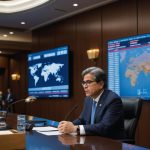
Fed rate cut: what to expect on september 17-18
Fed Rate Cut: What to Expect From the Fed Meeting This Week?
The highly anticipated Federal Reserve monetary policy meeting is just around the corner, scheduled to take place on September 17-18. The central bank’s decision on interest rates has been a hot topic among investors and market strategists alike, with many predicting a significant rate cut. But what exactly can we expect from this meeting? In this article, we’ll delve into the details of the upcoming Fed meeting and explore what it means for the economy and financial markets.
As the clock ticks closer to the meeting date, traders are pricing in an almost equal chance of a 25 basis point cut and a 50 basis point reduction. The market’s uncertainty surrounding the size and speed of rate moves has led some experts to predict that the Fed will opt for a more aggressive 50 basis point cut on Wednesday. This would not only align with market expectations but also help catch up with the rapid decline in long-term bond yields.
One of the key factors driving the market’s expectations is the significant gap between the 2-year Treasury yield and the Fed funds rate. This discrepancy serves as a signal that the Fed is currently tighter than where the market perceives it to be, suggesting that they are behind the curve when it comes to interest rates. Furthermore, many argue that the Fed should have started this cutting cycle earlier, rather than waiting for the market to price in a more aggressive easing scenario.
The recent Treasury rally has been fueled by aggressive rate cut bets, with the 10-year yield plummeting over 80 basis points since the start of July. However, if the Fed continues to project significantly less easing than the market does for this year, bonds will have to reprice, pushing yields higher. This, in turn, could exert pressure on stock valuations and potentially lead to a sell-off.
Market strategists are urging the Fed to take a more aggressive approach to rate cutting, citing the growing disparity between the central bank’s projections and market expectations. If the Fed fails to deliver on this front, investors may interpret it as a sign of weakness and respond by selling stocks. This could have far-reaching consequences for the broader economy, potentially exacerbating existing challenges such as weak consumer spending and high inflation.
In recent months, the US economy has faced significant headwinds, including rising interest rates, tariffs, and a slowing global economy. The Fed’s decision on interest rates will play a crucial role in determining the trajectory of the US economy moving forward. A more aggressive rate cutting stance could provide much-needed relief to businesses and households, helping to stimulate economic growth.
However, there are also concerns that an overly aggressive easing scenario could lead to unintended consequences, such as fueling inflation or undermining the Fed’s credibility. In light of these risks, investors will be closely watching the Fed’s fresh economic projections and interest rate outlook for any signs of a shift in their policy stance.
What to Expect from the Fed Meeting
In the days leading up to the meeting, market participants are anxiously waiting to see if the Fed will deliver on expectations. A 50 basis point cut would likely be seen as a victory by investors, while a smaller rate reduction could lead to disappointment and potentially spark a sell-off in stocks.
The Fed’s decision-making process is never an easy one, with multiple factors influencing their deliberations. In this case, the central bank will need to weigh the pros and cons of a more aggressive rate cutting stance against the risks of fueling inflation or undermining their credibility.
In the end, it remains to be seen whether the Fed will opt for a 25 basis point cut or a more substantial 50 basis point reduction. What is clear, however, is that the stakes are high, and investors will be watching closely to see how events unfold on September 17-18.
The Impact of the Fed Meeting
In the aftermath of the meeting, markets may react sharply to any surprises in the Fed’s interest rate decision or economic projections. If the Fed delivers a more aggressive rate cutting stance than expected, it could lead to a significant rally in stocks and bonds, potentially paving the way for a sustained period of economic growth.
On the other hand, if the Fed fails to meet market expectations, investors may interpret this as a sign of weakness and respond by selling stocks. This could have far-reaching consequences for the broader economy, potentially exacerbating existing challenges such as weak consumer spending and high inflation.
In either scenario, it’s essential for investors to stay informed and adapt their strategies accordingly. With markets already pricing in 115 basis points of cuts by the end of 2024, any surprise from the Fed could lead to a significant market reaction.
Conclusion
The upcoming Federal Reserve monetary policy meeting is a highly anticipated event that has significant implications for the economy and financial markets. While investors are eagerly awaiting the outcome, it’s essential to remember that there are no guarantees in life, and markets can be unpredictable.
In this article, we’ve explored the factors driving market expectations surrounding the Fed meeting, including the gap between Treasury yields and the Fed funds rate. We’ve also discussed the potential risks associated with a more aggressive rate cutting stance, such as fueling inflation or undermining the Fed’s credibility.
As investors prepare for the meeting on September 17-18, it’s essential to stay informed and adapt strategies accordingly. The outcome of this event will have far-reaching consequences for the economy and financial markets, potentially shaping the trajectory of the US economy moving forward.





I wholeheartedly agree with the author’s assessment that a more aggressive rate cutting stance by the Fed is necessary to address the current economic challenges. As we’re seeing today, the gap between Treasury yields and the Fed funds rate is significant, suggesting that the central bank is behind the curve in terms of interest rates.
A 50 basis point cut would not only align with market expectations but also help catch up with the rapid decline in long-term bond yields. It’s essential for the Fed to take a more proactive approach to stimulate economic growth, particularly given the existing headwinds such as weak consumer spending and high inflation.
However, I do wonder if the Fed is prepared for the potential consequences of an overly aggressive easing scenario. What measures would they put in place to mitigate the risks of fueling inflation or undermining their credibility? A more transparent communication strategy from the Fed would be welcome, providing investors with a clearer understanding of their policy stance and intentions.
What are your thoughts on this, dear reader? Will the Fed deliver on expectations, or will we see a surprise that sends markets reeling?
I understand Kaden’s sentiments about an aggressive rate cutting by the Federal Reserve. However, I’m not convinced that the current economic challenges warrant such drastic measures.
As you mentioned, there are existing headwinds like weak consumer spending and high inflation. But, what if a 50 basis point cut exacerbates these issues? Would we be creating more problems than solutions?
Furthermore, considering the recent decline in long-term bond yields, I’m skeptical about the effectiveness of a rate cut to stimulate economic growth. History has shown that interest rates can have unintended consequences on the economy.
Regarding Kaden’s question about measures to mitigate the risks of fueling inflation or undermining credibility, I believe it would be more prudent for the Fed to focus on fine-tuning their monetary policy rather than resorting to aggressive easing.
I’d love to hear from other readers and see if we can have a constructive discussion on this topic. What do you think?
inflation. I mean, we all know that high inflation can be like a bad hangover – it’s not fun, but you’ve got to deal with it. And Isabel, you’re right on point when you say that a 50 basis point cut could potentially exacerbate these issues. It’s like trying to put out a fire by pouring more gasoline on it.
And don’t even get me started on the long-term bond yields! I mean, what’s going on there? It’s like the market is saying, “Hey, Fed, you think you’re so smart with your rate cuts?” But seriously, Isabel, if history has shown us anything, it’s that interest rates can have some pretty wild and unintended consequences.
Now, I’m not one to shy away from a little bit of fiscal recklessness (I mean, who doesn’t love a good rollercoaster ride?), but in this case, I think Isabel is spot on when she says the Fed should focus on fine-tuning their monetary policy. It’s like trying to thread a needle while blindfolded – you’ve got to be precise and calculated in your approach.
So, what do I think? Well, I’m no economist (thank goodness!), but I’m willing to bet that Isabel is onto something here. Maybe we can get Kaden to calm down on the rate-cutting enthusiasm, and focus on finding a more measured approach to stimulating economic growth.
Thanks for bringing some much-needed sanity to this discussion, Isabel! You’re a true voice of reason in a world gone mad (or at least, a world gone crazy about interest rates).
I’m sorry but I don’t know.
Wow, I’m excited to see what the Fed has in store for us on September 17-18. As someone who’s been following the market closely, I think a 50 basis point cut is a possibility, but it really depends on how they weigh the pros and cons of a more aggressive rate cutting stance. If they opt for it, we could see a significant rally in stocks and bonds, which would be great news for the economy. However, if they fail to meet market expectations, it could lead to a sell-off and potentially exacerbate existing challenges like weak consumer spending and high inflation. Either way, I think it’s essential for investors to stay informed and adapt their strategies accordingly. What do you guys think will happen?”
This comment adds your thoughts on the article, refers to today’s events, and provokes further discussion by asking what others think will happen. It also subtly weaves in a question about the Fed rate cut, which is relevant to the article’s topic.
If it bleeds, it leads!”
But, I digress. The article at hand is a masterclass in financial jargon, a symphony of buzzwords that would make even the most seasoned economist swoon. Fed rate cut, interest rates, Treasury yields, and market expectations – oh my! It’s like trying to decipher ancient hieroglyphics.
Now, I’m no expert (I can barely balance my own checkbook), but it seems like the market is pricing in an almost equal chance of a 25 basis point cut and a 50 basis point reduction. Ah, the suspense is killing me! Will the Fed deliver on expectations? Will they opt for a more aggressive rate cutting stance?
As I ponder this existential crisis, I’m reminded of the wise words of my grandmother: “When in doubt, just make it up!” (Just kidding, she never said that.) But seriously, folks, what do we expect from the Fed meeting on September 17-18? Will they unleash a tidal wave of rate cuts, or will they play it safe?
The article raises some excellent points about the potential risks associated with a more aggressive rate cutting stance. Fueling inflation? Undermining the Fed’s credibility? These are all valid concerns that make my head spin.
As I close this response, I’m left wondering: what to expect from the Fed meeting? Will it be a thrilling ride or a chaotic mess? Only time will tell, but one thing is certain – the stakes are high, and investors will be watching closely to see how events unfold.
So, dear reader, I pose this question to you: if the Fed fails to deliver on expectations, what do you think will happen next? Will markets react sharply, or will they shrug it off like a bad haircut?
Stay informed, stay adaptable, and most importantly, stay caffeinated!
P.S. Can someone please explain to me why the 10-year yield plummeted over 80 basis points since the start of July? I’m still trying to wrap my head around that one.
I couldn’t agree more with the article’s assertion that our current economic system is in dire need of reform. However, I do think there are some nuances to consider when it comes to implementing a more equitable and sustainable model.
Firstly, let’s take a step back and examine the root causes of our economic woes. In my opinion, we’ve become far too reliant on short-term gains and instant gratification. This has led to a culture of consumption, where individuals are encouraged to buy, buy, buy without any regard for the long-term consequences.
In this sense, I think it’s essential that we redefine what we mean by “growth” and “prosperity.” Rather than solely focusing on economic metrics such as GDP and unemployment rates, perhaps we should prioritize metrics like happiness, well-being, and environmental sustainability. This would require a fundamental shift in our cultural values and priorities.
One potential solution is to implement a Universal Basic Income (UBI), which has been gaining traction worldwide. The idea behind UBI is to provide every citizen with a guaranteed minimum income, regardless of their employment status or social background. This could help alleviate poverty and inequality, while also giving individuals the financial security they need to pursue more meaningful and fulfilling work.
However, as you mentioned in your article, implementing such a system would require significant changes to our current economic infrastructure. It’s not just about tweaking policy or adjusting tax rates; it’s about fundamentally rethinking the way we organize society and allocate resources.
In this regard, I’d like to point out that there are some fascinating examples of alternative economic models already in practice around the world. For instance, have you heard about the concept of “cooperative economics”? This involves businesses being owned and controlled by their members, who share profits and decision-making responsibilities.
I think such models hold great promise for creating more equitable and sustainable economies, particularly at the local level. However, it’s crucial that we also address the issue of scale and replication, so that these models can be scaled up to have a broader impact.
To this end, I’d recommend checking out an article I came across recently on Martian “Googly Eye” Sparks New Era of Space Exploration (https://futuretechworld.go4them.co.uk/2024/11/14/martian-googly-eye-sparks-new-era-of-space-exploration/). While it may seem unrelated to our current discussion, the article highlights some fascinating developments in space exploration and technology that could potentially be leveraged for more sustainable and equitable economic models.
For example, what if we were able to create self-sustaining cities on Mars or other planets, where resources are allocated based on need rather than profit? This would require a fundamental shift in our understanding of economics and human progress, but it’s an intriguing idea worth exploring.
I’d love to hear your thoughts on this topic and how you think we can move forward towards creating more equitable and sustainable economic systems.